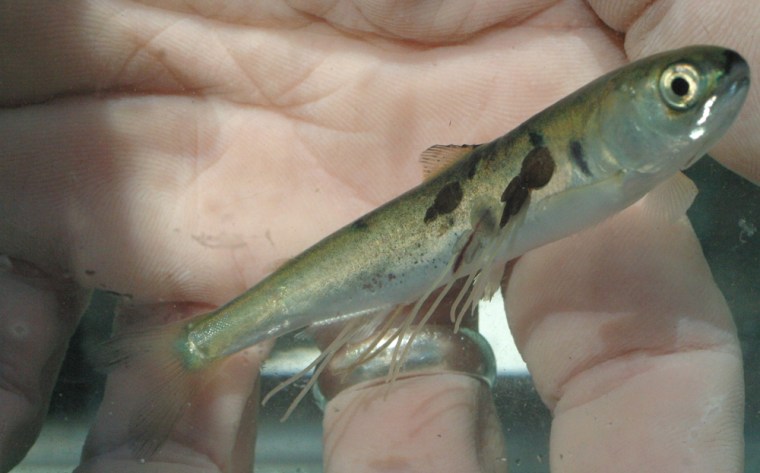Sea lice infestations from salmon farms can drive populations of wild salmon toward extinction, and in fact that's happening in Canada's British Columbia, scientists reported Thursday in the journal Science.
After examining four decades of data on pink salmon in the Broughton Archipelago, the experts said those populations have been rapidly declining over the last four years. The researchers expect a 99 percent collapse in another four years — or two salmon generations — if the infestations continue.
"The impact is so severe that the viability of the wild salmon populations is threatened," lead author Martin Krkosek, a fisheries ecologist at the University of Alberta, said in a statement that accompanied the study.
The researchers calculate that sea lice have killed more than 80 percent of the annual pink salmon returns to the archipelago, a group of islands about 260 miles northwest of Vancouver.
The Canadian Department of Fisheries and Oceans, which regulates salmon farms and is responsible for protecting wild salmon, said the study overstates the risks, which are not consistent with figures for pink salmon returns since 2002, when populations collapsed.
"They are asking us to believe 80 percent mortality is from one source," said Brian Riddell, head of the salmon science branch of the department's Pacific Biological Station in Nanaimo, B.C. "That's simply unrealistic."
Previous studies have shown that sea lice from fish farms can infect and kill juvenile wild salmon. The new study is the first to examine the impacts on overall wild salmon stocks.
'Dead obvious' decline
"It shows there is a real danger to wild populations from the impact of farms," said Ray Hilborn, a University of Washington fisheries biologist who was not involved in the study.
"In terms of anything like statistical significance, it's dead obvious that counts of fish from those streams in years juveniles swam by farms that were active is much lower," he said. "It is a very localized effect," he said, not likely to threaten pink salmon populations in general.
Hilborn added that the study "is really about a lot more than salmon. It is about the impacts of net pen aquaculture on wild fish. This is the first study where we can evaluate these interactions and it certainly raises serious concerns about proposed aquaculture for other species such as cod, halibut and sablefish."
In nature, sea lice only latch onto fish skins when salmon are older. But the presence of salmon farms near wild salmon runs means that juvenile salmon are exposed as well. In Broughton Archipelago, juvenile salmon pass two dozen fish farms — some holding a million fish — over a stretch of 50 miles before they reach the open ocean.
"Salmon farming breaks a natural law," said co-author Alexandra Morton, director of the Salmon Coast Field Station, located in the Broughton. "In the natural system, the youngest salmon are not exposed to sea lice because the adult salmon that carry the parasite are offshore. But fish farms cause a deadly collision between the vulnerable young salmon and sea lice. They are not equipped to survive this, and they don’t."
Repercussions elsewhere
The researchers noted that what happens to salmon has repercussions elsewhere, from killer whales that rely on salmon for food to communities that rely on nature tourism.
"An important finding of this paper is that the impact of the sea lice is so large that it exceeds that of the commercial fishery that used to exist here," said co-author Jennifer Ford, a fisheries scientist at Dalhousie University. "Since the infestations began, the fishery has been closed and the salmon stocks have continued declining."
Moving fish farms away from rivers or containing farmed fish in closed pens — as opposed to the existing open, netted pens — have been proposed as solutions.
The fish farm industry has resisted both ideas, but a British Columbia government report last May recommended a move towards closed containment within five years.
